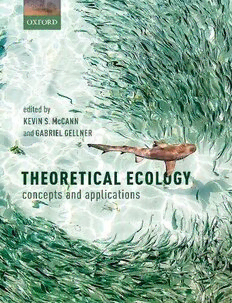
Theoretical Ecology: Concepts and Applications PDF
Preview Theoretical Ecology: Concepts and Applications
OUPCORRECTEDPROOF – FINAL,25/5/2020,SPi TheoreticalEcology OUPCORRECTEDPROOF – FINAL,25/5/2020,SPi OUPCORRECTEDPROOF – FINAL,25/5/2020,SPi Theoretical Ecology Concepts and Applications EDITED BY Kevin S. McCann and Gabriel Gellner DepartmentofIntegrativeBiology,UniversityofGuelph,Canada 1 OUPCORRECTEDPROOF – FINAL,25/5/2020,SPi 3 GreatClarendonStreet,Oxford,OX26DP, UnitedKingdom OxfordUniversityPressisadepartmentoftheUniversityofOxford. ItfurtherstheUniversity’sobjectiveofexcellenceinresearch,scholarship, andeducationbypublishingworldwide.Oxfordisaregisteredtrademarkof OxfordUniversityPressintheUKandincertainothercountries ©OxfordUniversityPress2020 Themoralrightsoftheauthorshavebeenasserted FirstEditionpublishedin2020 Impression:1 Allrightsreserved.Nopartofthispublicationmaybereproduced,storedin aretrievalsystem,ortransmitted,inanyformorbyanymeans,withoutthe priorpermissioninwritingofOxfordUniversityPress,orasexpresslypermitted bylaw,bylicenceorundertermsagreedwiththeappropriatereprographics rightsorganization.Enquiriesconcerningreproductionoutsidethescopeofthe aboveshouldbesenttotheRightsDepartment,OxfordUniversityPress,atthe addressabove Youmustnotcirculatethisworkinanyotherform andyoumustimposethissameconditiononanyacquirer PublishedintheUnitedStatesofAmericabyOxfordUniversityPress 198MadisonAvenue,NewYork,NY10016,UnitedStatesofAmerica BritishLibraryCataloguinginPublicationData Dataavailable LibraryofCongressControlNumber:2020930792 ISBN978–0–19–882428–2(hbk.) ISBN978–0–19–882429–9(pbk.) DOI:10.1093/oso/9780198824282.001.0001 Printedandboundby CPIGroup(UK)Ltd,Croydon,CR04YY LinkstothirdpartywebsitesareprovidedbyOxfordingoodfaithand forinformationonly.Oxforddisclaimsanyresponsibilityforthematerials containedinanythirdpartywebsitereferencedinthiswork. OUPCORRECTEDPROOF – FINAL,25/5/2020,SPi Foreword Robert D.Holt The word “theory” in its broadest sense has to reflecting maturation of our discipline. In the cur- dowithaframeworkofconceptualconstructsthat rent volume there is much more emphasis than in help explain or interpret phenomena in a particu- 1976onthekeyroletheinternalstructuresofpopu- lar domain (Pickett et al. 2007). The discipline of lationsplayintheirdynamics,andonstochasticity, ecology has in some of its branches robust theory lags, and transient dynamics—all crucial ingredi- thatisnotparticularlymathematical(Scheinerand entsinbringingtobeartheoryonimportantapplied Willig 2011). More narrowly construed, however, questions.Thereismuchmoreemphasisinthecur- “theoreticalecology”pertainstotheuseofmathe- rentvolumeonaspectsofecologicalcomplexitythat matical and computational models to explore eco- canberenderedasnetworks,oninteractionsamong logicalquestions,rangingfromindividualbehavior, species,onparasitesinflictinghosts,andonflowsof throughtheintertwinedcomplexitiesofcommuni- individualsacrossspace.Acentralthemeinmany ties, to even global-scale phenomena. This is the chaptersiselucidatingtherelationshipbetweennet- senseinwhichRobertMayusedthetermincrafting workstructure,andthestabilityandrobustnessof theseriesofadvancedtextstitled“TheoreticalEcol- ecologicalsystems—anabidingthemeinMay’sown ogy,”aninfluentiallineageofvolumesnowstretch- researchcontributions. ingbacknearlyhalfacentury.Ahistorianofecology In1976,onechapterwasonschistosomiasis;now, could glean much insight into the development of emphasis is placed on the community context of ecologyatitsconceptualcorebycarefullyperusing infectiousdisease.Appliedissues(e.g.,schistosomi- thecontentsofthesevolumes,startingwiththefirst asisasacasestudy)in1976weresomewhatloosely edition in 1976, and now manifest in the current tiedtoecologicaltheory,butinthepresentvolume, fourthedition.Mayhimselfhasplayedacentralrole issues such as the role of diversity in infectious inthematurationoftheoreticalecology,andevenin disease dynamics, abiotic drivers of interspecific thisvolumenearlyallthechaptersciteoneormore interactions, and the quest for early warning sig- ofhismanypapersandbooks. nalsofimpendingradicalchange,squarelybuildon As noted by the editors, comparing the table other areas of ecological theory. The 1976 volume of contents of the timely and authoritative book nodded towards evolution, for instance, with dis- you have before you, with the 1976 first edition, cussions of bionomic strategies and sociobiology; is quite revealing. They both start with a focus thecurrentvolumeincludesthemessuchasadap- onsinglespeciesdynamicsandinteractionsamong tive dynamics as tools for examining trait evo- a small number of species, then build to multi- lution in a community context. One could well speciesensemblesbeforeendingwithapplications, imagine that the fusion of ecology and evolution andareall writtenbyleadingauthorities. Butitis will become a central theme in yet future editions instructive to ponder the differences in emphases, of this renowned text (see Pásztor et al. 2016 for a v OUPCORRECTEDPROOF – FINAL,25/5/2020,SPi vi FOREWORD perceptive synthesis, grounding ecological theory biodiversity on our planet mandates a clear and onDarwinianprinciples). rigorous understanding of the factors that govern In the final chapter in this volume, the editors their persistence and spatial arrangements and reflect on likely “Areas of Current and Future temporalfluxes,inthefirstplace. Growth,” specifically noting seasonal drivers The ideas summarized in this splendid volume, of dynamics, ecosystem issues, coupled social- carryingon the grand tradition Robert Mayestab- ecological systems, and grappling with the many lishedstartingin1976—fromcoexistencetheory,to dimensions of change in the world. In closing, I network analyses, to embracing stochasticity and wanttoreturntoRobertMay’sownclosingchapter lags, to grounding theory on an underpinning of in the third 2007 edition of Theoretical Ecology (co- keyindividualtraitsandsubtleissuesofpopulation edited with Angela McLean), titled “Unanswered structure—areessentialingredientsneededforsuch questions and why they matter,” which mulls on understanding.Allactiveecologists,fromstudents the consequences of the current largest driver of toseasonedpractitioners,wouldbenefitfromread- change on the planet—ourselves. May remarks on inganddigestingthechaptersinthisvolume,andI thestartlingsingularityofourpointintime,when applaudtheeditorsandauthorsonthefruitsoftheir overafewgenerationsourspecieshasburgeonedin labors. numbers,withcorrespondingimpactsontheplanet. May cites an estimate that will reach 9 billion by 2050;themodalprojectionoftoday’sdemographic References models worrisomely is even higher, at 9.8 billion. Backin1800,wellwithinthelifespanofmanyforest Pásztor, L., Z. Botta-Dukát, G. Magyar, T. Czárán, and trees still standing, there were only 1 billion or so G. Meszéna. 2016. Theory-based Ecology: A Darwinian Approach.Oxford,UK:OxfordUniversityPress. ofus.Maythenremarksthatbysomeestimates,we Pickett,S.T.A.,J.Kolasa,andC.G.Jones.2007.Ecological have already exceeded the “ecological footprint” Understanding: The Nature of Theory and the Theory of ofsustainability,andendswithreflectionson“the Nature. 2nd edition. Burlington NY: Academic Press, aspiration of optimizing the preservation of our Elsevier. evolutionaryheritage.”Theethicalgoalofpassing Scheiner,S.M.andM.R.Willig.2011.TheTheoryofEcology. on to future generations some of the richness of ChicagoIL:UniversityofChicagoPress. OUPCORRECTEDPROOF – FINAL,25/5/2020,SPi Detailed table of contents Listofcontributors xiii 1 Introduction 1 GabrielGellner,KevinS.McCann,andEmilyJ.Champagne 1.1 Thisbookanditspredecessors 1 1.2 Thisbook:Themesanddirections 2 2 Speciescoexistence 5 PeterChesson 2.1 Introduction 5 2.2 Models 6 2.3 Overallinteractionandaveragefitnessdifferences 11 2.4 Competitionforresources 12 2.5 Roleofnaturalenemies 15 2.6 Roleofenvironmentalvariation 18 2.7 Discussion 21 Acknowledgments 24 References 24 3 Thesynergisticeffectsofinteractionstrengthandlagsonecologicalstability 28 GabrielGellner,KevinS.McCann,andChristopherGreyson-Gaito 3.1 Introduction 28 3.2 Populationmodels:Theinteractiveroleofgrowthandlags 31 3.3 Consumer-Resourcemodels:TheinteractiveroleofISandlags 34 3.4 Lagexcitationandlaginterference 36 3.5 Asynchronyasaformoflaginterference? 36 3.6 Summary 38 References 38 4 Non-equilibriumdynamicsandstochasticprocesses 40 KarenC.Abbott 4.1 Introductiontostochasticityandtransients 40 4.2 Challenge1:Stabilityinstochasticecologicalsystems 42 4.2.1 Whyisthisachallengefornon-equilibriumsystems? 42 4.2.2 Awayforward 44 4.2.3 LessonfromChallenge1:Non-equilibriumdynamicsstrengthen ecologicalunderstanding 46 vii OUPCORRECTEDPROOF – FINAL,25/5/2020,SPi viii DETAILED TABLE OF CONTENTS 4.3 Challenge2:Predictingregimeshifts 46 4.3.1 Whyisthisachallengefornon-equilibriumsystems? 46 4.3.2 Awayforward 46 4.3.3 LessonfromChallenge2:Unstableequilibriacanrevealalotabout non-equilibriumdynamics 49 4.4 Buildingontheselessonstoconfrontfuturechallenges 50 References 51 5 Theimpactofpopulationstructureonpopulationandcommunitydynamics 53 AndréM.deRoos 5.1 Introduction 53 5.2 StateconceptsinSPMs 54 5.3 Typesofstructuredpopulationmodels 55 5.4 Ecologicalconsequencesofchangingpopulationstructure 60 5.4.1 Juvenileandadult-drivenpopulationcycles 60 5.4.2 Biomassovercompensation 62 5.4.3 Communityconsequencesofbiomassovercompensation 64 5.5 Interfacingtheoryanddata 67 5.6 Ongeneralityandmodelspecificity 69 5.7 Outlook 70 References 71 6 Modelsforlargeecologicalcommunities—arandommatrixapproach 74 StefanoAllesinaandJacopoGrilli 6.1 Introduction 74 6.2 May’sstabilitycriterion 75 6.3 Randommatrices 78 6.4 Fundamentalresults 79 6.5 Structuredrandommatrices 83 6.6 Otherapplications 88 6.7 Openproblemsandconclusions 89 References 91 7 Astructuraltheoryofmutualisticnetworks 93 JordiBascompteandAntonioFerrera 7.1 Introduction 93 7.2 Apurelydynamicstabilityapproachtomutualisticnetworks 95 7.2.1 Earlymodels 95 7.2.2 Addingnon-linearfunctionalresponses 95 7.2.3 Addinginterspecificcompetitionwithinsets 97 7.3 Astructuralstabilityapproachtomutualisticnetworks 99 7.3.1 Preliminaryworkonthelimitstothenumberofcoexisting speciesinpurelycompetitivesystems 99 7.3.2 Limitstothenumberofcoexistingspeciesinsystemswith competitionplusmutualism 104 7.3.3 Robustnessofmutualisticnetworks 108 7.4 Concludingremarks 113 References 114 OUPCORRECTEDPROOF – FINAL,25/5/2020,SPi DETAILED TABLE OF CONTENTS ix 8 Adata-drivenapproachtocomplexecologicalsystems 116 MichioKondoh,KazutakaKawatsu,YutakaOsada,andMasayukiUshio 8.1 Interspecificinteractionsandecologicaldynamics 116 8.1.1 Populationdynamicsandinterspecificinteractions 116 8.1.2 Communitydynamicsandinterspecificinteractions 117 8.2 Natureofpopulation-levelinterspecificinteractions 119 8.2.1 Diversityinbehavioralmechanisms 119 8.2.2 Scaledependencyofinterspecificinteractions 119 8.2.3 Dynamicnatureofinterspecificinteractions 120 8.3 Howtostudyinterspecificinteractionsinnature 121 8.3.1 Identifyingpopulation-levelinteractions 121 8.3.2 Identificationofinteractionsbasedonbehaviorbyindividuals 121 8.3.3 Manipulativefieldexperiments 122 8.4 Moderndata-drivenapproachtointerspecificinteractions 123 8.4.1 Estimatingpopulation-levelinteractionsfromtime-seriesdata 123 8.4.2 ConvergentcrossmappingandmultivariateS-map 124 8.4.3 ApplicationofEDMtointeractionnetworkstudies 125 8.5 Conclusionandfuturedirections 128 References 129 9 Trait-basedmodelsofcomplexecologicalnetworks 134 UlrichBrose 9.1 Modelingcomplexecologicalnetworks 134 9.2 Allometricpopulationmodels 136 9.3 Allometricmodelsofcomplexcommunities:TheYodzis andInnesapproach 137 9.4 Morecomplexallometries 138 9.5 Modelingthetemperature-dependenceofnetworkdynamics 139 9.6 Outlook 139 References 141 10 Ecologicalnetworks:Fromstructuretodynamics 143 SoniaKéfi 10.1 Briefintroduction 143 10.2 Whatisanetwork? 144 10.3 Networksinecology 146 10.3.1 Interactionnetworks 146 10.3.2 Towardmulti-layerinteractionnetworks 147 10.3.3 Othertypesofecologicalnetworks 147 10.3.4 Broadquestionsaskedinecologicalnetworks 149 10.4 Quantifyingnetworksstructure 149 10.4.1 Localnetworkdescriptors 150 10.4.2 Quasi-localnetworkdescriptors(intermediatedescriptionlevel) 150 10.4.3 Globalnetworkdescriptors 150 10.4.4 Extensionstomultilayernetworks 152 10.5 Structuralpropertiesofecologicalnetworks 152 10.5.1 Foodwebs 152 10.5.2 Mutualisticwebs 154
